Harsh Budget Realities Redefine Future Forces
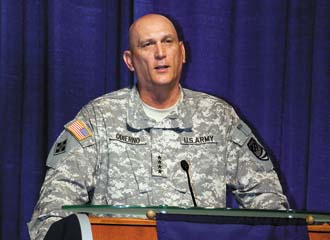 |
Gen. Raymond T. Odierno, USA, commander, U.S. Joint Forces Command, discusses national security issues at Joint Warfighting 2011. |
The severity of the global financial crisis has permeated budgeting within the defense sector, and indications are that the cuts will go far deeper than many of the experts believe is practical. As a result, the task at hand is to shape the future in a very different budget environment than ever before, with leaders being challenged to make decisions without the benefit of historical models. The fiscal crisis in the United States is its primary security threat today, according to Gen. Raymond T. Odierno, USA, former commander, U.S. Joint Forces Command.
Gen. Odierno joined other high-ranking military and civilian officials offering nontraditional glimpses of the future at Joint Warfighting 2011, held May 10-12 in Virginia Beach, Virginia.
For all that has changed in the budget environment, some constants in the world cannot be overlooked, advised Adm. Gary Roughead, USN, chief of Naval Operations. One of his many concerns about looming budget cuts is that the industrial base could be degraded in the process, hurting the United States’ ability to respond to world events in the future. Decision makers must keep in mind that the nature of the industrial base is fragile, and it cannot be re-created if lost, the admiral cautioned.
Achieving the sizable cuts being called for in the defense budget requires a strategy to determine what the military is willing to stop doing, and that has to be followed by a national security discussion, Gen. Odierno explained. “From a policy perspective,” he said, “we have to decide which cuts are going to result in savings and reductions and then see if we can accept the risks.”
One prime goal of defense budget reduction strategies is to eliminate redundancy, and one way to address this problem is with a more integrated force. Military and civilian government organizations both must mitigate reduced capacity by working together, and military leaders must have a view that encompasses all the services, Gen. Odierno advised.
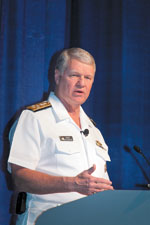 |
Adm. Gary Roughead, USN, chief of Naval Operations, warns of a degrading industrial base if budget cuts are not handled properly. |
Contractor roles also are under scrutiny. Contractor services in the current military budget, for the first time, are equal to contracts for products, explained Raymond Haller, senior vice president and director of The MITRE Corporation’s Defense Department Command, Control, Communications and Intelligence federally funded research and development center. Strategic relevance will be the acid test for contractors, he explained.
Contractors will see cuts in personnel areas, but the military will continue to buy items and ideas, according to a former Defense Department comptroller. “Companies providing people who flip badges when they retire will have problems,” declared Dr. Dov S. Zakheim, who now is a senior adviser, Center for Strategic and International Studies and senior fellow, CNA Corporation.
Yet the United States is not alone in experiencing defense reductions. Across Europe, defense is being underfunded by between 20 and 40 percent. This is an incredible reduction in defense spending, and frankly quite dangerous, said Vice Adm. Robert G. Cooling, RN, chief of staff, NATO Allied Command Transportation. In this environment, everyone needs allies, he suggested. Fighting along with NATO is better than fighting ad hoc.
Global trade and economic interest will direct the interaction of all states, and the speed of these actions in the information age and the speed with which events develop will change the ability to lead developments, Adm. Roughead noted. The stakes of growing complexity and disorder are high, and joint integration has increasing value.
And the United States faces increased threats from abroad that could negate its superiority in many key military disciplines, unless it re-dedicates itself to investment in progress, according to Michael W. Wynne, former secretary of the Air Force. He warned that the United States is dropping its guard in equipping the force for future conflict.
“We have been lulled into a sort of lethargy by doing what we should be doing—exploiting the concept of total air dominance,” Wynne said, using the Air Force as an example to discuss the challenge. Potential enemies are moving ahead with efforts to negate the U.S. high-technology military through direct countermeasures or the deployment of equivalent, or peer, equipment.
“As a nation, we are turning away from consolidating our gains,” Wynne stated. “We have achieved much by dominating the third dimension. These gains did not come without standards and vision.”
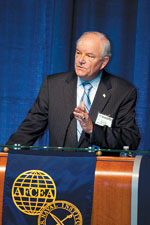 |
Michael W. Wynne, former secretary of the Air Force, cautions that the United States may be losing its qualitative edge in equipping the force for the future. |
Existing communications and network systems especially are vulnerable, and not just because of direct action. Wynne pointed out that software and data flow offer their own problems. Networks are drowning in gigabytes of data: “We are burying our transmission systems in irrelevant imagery,” he said.
That challenge is complicated by inadvertent problems and potential enemy action. Jamming and the loss of spectrum control by cohabitating electromagnetic signals is a threat to networked operations, Wynne pointed out. He predicted that the next war could be first to fiber, as the ability to transmit could be corrupted or jammed by enemy operations.
“I don’t think we can wait for data Armageddon,” he said.
Malicious threats in cyberspace are entering a new territory that is more menacing than previously experienced, according to the deputy commander of the U.S. Cyber Command. Lt. Gen. Robert E. Schmidle, USMC, offered that cyberspace is seeing the beginnings of the development of new types of destructive tools. These tools are software that has no purpose other than to destroy legitimate software or even hardware, he explained.
The general also warned that cyberspace security experts no longer can afford the luxury of traditional security that detects malicious operations when they begin. This active approach must be extended across the civilian realm of cyberspace as well as in the military arena, he said.
“You can’t have static defense where you wait for something to happen,” Gen. Schmidle declared. “You’ve got to be out in the network hunting for malware.”
One approach is an agile tipping and cueing capability similar to that employed in signals intelligence, or SIGINT. Applying that approach to cybersecurity would help head off threats before they achieved their malicious goals.
Gen. Schmidle allowed that the .mil network is well-protected, but huge vulnerabilities exist in other networks that also are vitally important. “There are critical pieces of our infrastructure, part of our national security, that must be robustly defended against threats,” he warned.
A panel of experts offered that future adversaries likely will wage new types of warfare against U.S. and coalition forces based on varying types of conflict. “I worry about disruptive threats such as cyber and EW [electronic warfare],” said Lt. Gen. William J. Rew, USAF, vice commander, Air Combat Command. The general expressed concern that the younger generation, which always has had Global Positioning System (GPS) technology available, may be ill-equipped to handle warfare when those high-technology capabilities are denied. He related that the Air Force injected a significant amount of that activity into a war game at Nellis Air Force base recently, and that caused significant problems with participants.
A similar position was adopted by Lt. Gen. Dennis J. Hejlik, USMC, commander, U.S. Marine Corps Forces Command. “On the cyber side, the question is who’s out there that is going to take some magical moments away from us,” he declared. “There are some smart enemies out there” that might deny effective use of GPS, for example, the general said.
Lt. Gen. Robert L. Caslen Jr., USA, commanding general, U.S. Army Combined Arms Center and Fort Leavenworth, offered that the future threat is probably a sort of a hybrid threat, such as Hezbollah in its operations against Israel. This is a nonstate adversary that wages new types of asymmetrical warfare, but because of its state sponsorship from Iran, it has some state capabilities.
 |
Adm. John T. Harvey, USN, commander of the U.S. Fleet Forces Command, urges that the services be resourced to be able to carry out their core missions. |
Given that uncertainty, the services must plan so that they are not unable to contribute to a joint mission. Budget cuts are coming—“White water ahead as far as the eye can see”—and the services must be able to sustain their defining capabilities, as none of the services will have the funds to re-procure the force as they have in the past, the admiral said.
The foundation of the joint force is composed of contributing service units that are whole—well-equipped, well-trained, operating with confidence—provided by each of the services, he continued. Without that contribution, the joint force will not succeed.
“The individual services must be properly resourced to deliver whole units to carry out their missions—especially in service-unique missions—in a joint environment,” Adm. Harvey explained. With reduced funding, the services will have to make tough decisions on how they will deliver their core competencies.
United States Must Maintain Power, Influence in Asia-Pacific
The United States must continue to have a strong military, economic and political presence in the Asia-Pacific region for the foreseeable future, according to experts in a Joint Warfighting 2011 plenary panel session hosted by former Good Morning America host David Hartman. This is necessary to counterbalance increasing Chinese influence and to keep the United States’ status as an honest security broker in the region.
Wallace “Chip” Gregson, former assistant secretary of Defense for Asian and Pacific Security Affairs, said that U.S. friends in the region want the United States to represent its values peacefully. Ronald O’Rourke, a specialist in national defense with the Congressional Research Service, opined that, every day, nations throughout the region are taking the measure of each country’s strength. It is politically important for the United States to stay strong militarily on a continuing basis. Many countries have not yet taken sides in the foreign policy debate between the United States and China, he noted.
And China is strengthening its economic ties with many other countries. Gregson observed that many Asians have risen out of poverty because of China’s economic growth. He cited Cambodia as an example: The Southeast Asian country expressed a desire for a strong U.S. presence, but meanwhile China is helping build the country’s infrastructure. “China is there, and we’re not,” he said.
Both Gregson and O’Rourke, along with fellow panelist Adm. Timothy J. Keating, USN (Ret.), former head of the U.S. Pacific Command, maintained that the United States is not a fading power relative to China. Reports of waning U.S. influence have been greatly exaggerated. However, all three panelists said that the United States must continue to take steps to maintain its power and accompanying prestige to avoid that fate.
The panelists agreed that the United States and China are not likely to go to war with each other because neither country wants it and it would run counter to both nations’ best interests. Adm. Keating noted that China actually wants the United States to remain active in the Asia-Pacific region as a hedge against any other country’s adventurism. And, most of the other countries in that region want the United States to remain active as a hedge against China.
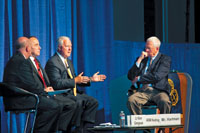 |
Former Good Morning America host David Hartman (r) listens as Adm. Timothy J. Keating, USN (Ret.), former head of the U.S. Pacific Command (2nd r), discusses U.S. relations with China. Other panelists are (l-r) Ronald O’Rourke, a specialist in national defense with the Congressional Research Service, and Wallace "Chip" Gregson, former assistant secretary of defense for Asian and Pacific security affairs. |
As for Taiwan, Adm. Keating offered that with each day, the likelihood of a Chinese attack on Taiwan diminishes. Economic ties between the two governments are growing, as is social interaction. He predicts that a gradual solution to reunification is coming. The United States can hasten that process by remaining a powerful force in the region, he added.
Technology, Missions Dominate Planning
Burgeoning capabilities and operational alterations are wild cards that are challenging planners. Technology changes are happening quickly, and potential missions are increasing in number and variety. In many cases, analysts are forced to divide and conquer by isolating disciplines in search of solutions.
This year’s Joint Warfighting Conference featured specialized presentations in an exhibit floor area designated Engagement Theater. In one, Jason Howe, a strategic analyst with the U.S. Air Force Air Combat Command’s (ACC’s) Chief Technology Office, discussed the impact of mobile communication and its value beyond email and phone calls. Howe said he believes the shift to mobile is already here, and “even email is giving way to text, chat and other more immediate forms of communication.” In the future, he said, the Air Force must reduce friction among communication channels and make users more effective regardless of location.
The key to mobile success is convergence, Howe explained. In the applications space, the emphasis will be on device-agnostic programs using HTML-5. “Companies don’t want to keep supporting multiple applications on different platforms,” he said, adding that the current Defense Department strategy to make an app store for device-specific programs needs to adapt.
Squadron Leader Joe Rushton, RAF, an exchange officer and engineer with the ACC Chief Technology Office, explored the challenge of building an integrated Air Force strategy to unify voice, video and data services while simplifying delivery and reducing costs. The Defense Information Systems Agency is taking the lead on unified communications and collaboration across the Defense Department, the squadron leader said, and the Air Force is putting together its own plan to complement the effort. The vision is to increase decision superiority for the warfighter and provide increased mission effectiveness.
The Air Force plan initially will aim to unify six communications stovepipes: instant messaging; voice and video conferencing; peer-to-peer video and video teleconferencing; desktop collaboration; unified messaging; and presence-enabled business processing. An enterprise local session controller will connect and provide services out to these end instruments to increase warfighter communication and information sharing. This common network infrastructure is more efficient and inexpensive in the long term despite the upfront cost for implementation, Squadron Leader Rushton said.
 |
Rear Adm. James A. Watson, USCG, deputy commander, U.S. Coast |
Additionally, the Coast Guard faces many maritime border challenges, including fully submersible fleets delivering drugs. “We have a long way to go before we even come close to shutting these guys down,” Adm. Watson allowed. Moving forward, the Coast Guard plans to focus on a small-vessel security strategy. A total of 19 million recreational boats are registered in the United States, the admiral related, and they can be totally anonymous while floating among military vessels.
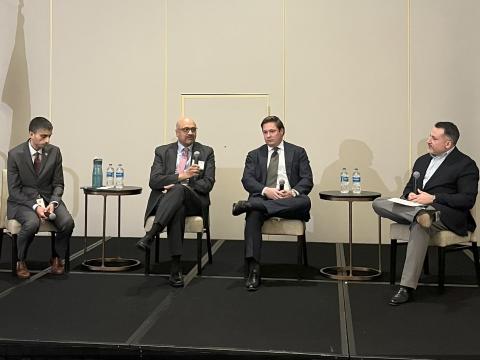
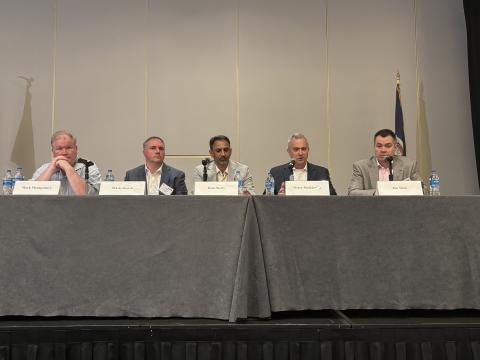
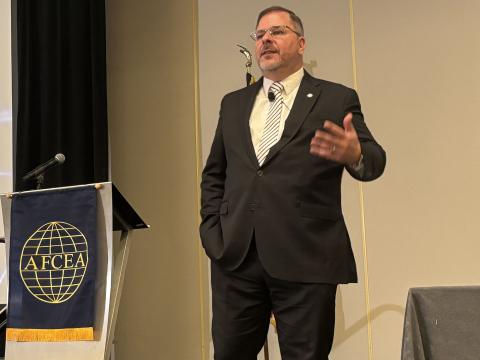

Comments